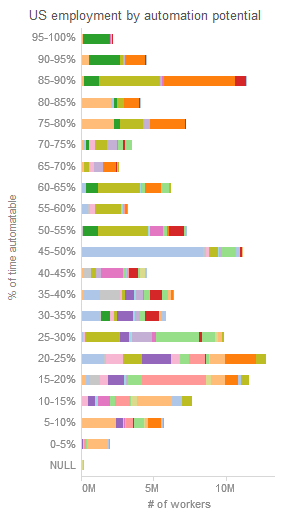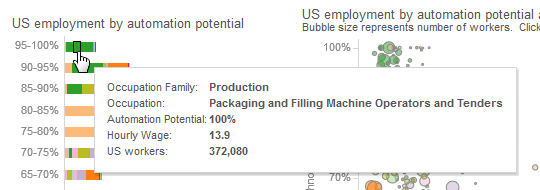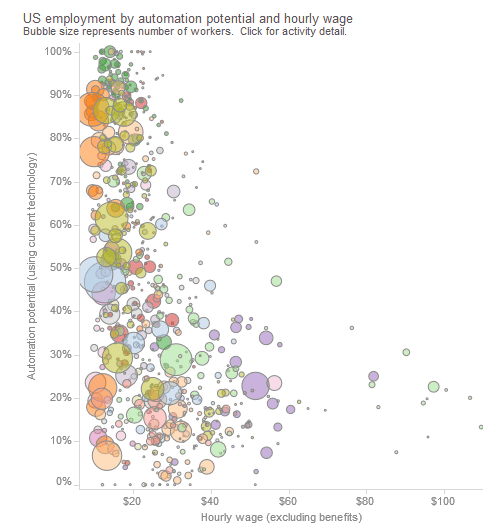Data of a masterpiece summarizing the "occupation possibly automated by machines in the future" to be helpful for thinking about job hunting and career change

ByKyle Welsby
If you are thinking about getting a job or changing jobs, it might be worth thinking about "How does automation by machines influence the future profession?" State-of-the-art technologies such as artificial intelligence (AI) and robots are beginning to exert a major influence on the labor market, and there are plenty of possibilities that some occupations will not need human hands.
Four fundamentals of workplace automation | McKinsey & amp; Company
http://www.mckinsey.com/business-functions/digital-mckinsey/our-insights/four-fundamentals-of-workplace-automation
How Soon Before Your Job Is Done By A Robot? This Handy Chart Will Tell You | Co.Exist | ideas + impact
https://www.fastcoexist.com/3054842/visualizing/how-soon-before-your-job-is-done-by-a-robot-this-graphic-will-tell-you
It is McKinsey of the global consulting firm that studied about "How does machine automation affect the future profession?" It is McKinsey of the global consulting firm, and in the future research on 750 kinds of occupations that may be automated by machine I announced the result. As a result of the survey, it is believed that 45% of the profession paying wages can be automated using "presently proven technology", and in addition 60% of existing occupations are "30 It is possible to automate work with a probability of% or more ".
A graph summarizing the survey results published by McKinsey can be found on the following page.
Automation and US Jobs - McKinsey Global Institute | Tableau Public

Survey data is also published in embedded format, and if you hit the mouse cursor on the graph below, it is displayed "what kind of occupation is it?" Applicable to the relevant part.
The data shown are three graphs, the graph below shows the possibility that the labor force in the US automates by the machine, and the horizontal axis shows the labor force population. 95 to 100% of the vertical axis shows "the job is automated by the machine with a probability of 95 to 100% in the future", that is, "occupation in which the machine is deprived of work by a high probability in the future" Why

When you hit the mouse cursor, the corresponding job category will be displayed as shown below. In the following cases, the job category is "Operator of packaging and bagging machine", and the probability of future automation is 100%. Hourly wage is $ 13.9 (about 1600 yen), in the United States about 370,000 people are in the same profession, and so on, we can see information up to a fairly detailed part.

On the graph next to it, the vertical axis shows the possibility of future automation, and the horizontal axis shows hourly wage. The size of the circle displayed on the graph shows the size of the population currently occupied by that occupation.

If you hit the mouse with a large circle of size 40 to 50% on the trial, the professional system is "sales related", the job type is "retail store sales person", the possibility of future automation is 47%, hourly wage Was about 13 dollars (about 1500 yen) and the labor force population was about 4.5 million people.

Below the two graphs, the graph shows the labor force on the vertical axis and the hourly rate on the horizontal axis.

What is the rich occupation that it receives 105 to 110 dollars (about 12,000 to 12,600 yen) in hourly conversion?

And at the right end of the three graphs, the following occupations and ranking of the working population are displayed ... ...

You will be able to see the location of the corresponding job in the three graphs by clicking on it. This time the job class is "Food cooking and serving related", with a working population of about 12 million people.

Workers who conduct "cooking foods, preparing foods, preparing foods" which are most likely to be automated mostly among occupational strains "food preparation and serving related".

The classification seems to be very detailed, and workers who do "cooking, simple orders" ... ...

Even a composite role such as cooking and serving, such as workers who do "cooking and serving complex foods" are classified differently.

Also, from "Occupation (occupation)" you can also investigate the possibility of automating occupation of your interest.

For example, if you select only "Bartenders" ...

Only the information of the bartender is displayed on the graph like this. According to this, the probability that the work of the bartender will be automated in the future is 68%.

There are several professions that are expected to automate 100% work in the future, such as operator of bagging machines, professionals of medical equipment, occupation grading agricultural crops, sewing machine operators, etc. Also, there are also butchers, meat processing, bakeries, bus mechanics, laundry machines etc., which are predicted to be automated with high probability. The probability that security guards work automates is calculated to be 40%, but some jobs have already been replaced by machines. In addition, some occupations have low probability of automation, for example, 28% in the case of computer system analysts, the possibility of depriving the machine of jobs seems to be rather low.
Related Posts:
in Note, Posted by logu_ii







